Flower Properties
| Property | Value |
|---|---|
| English Name | Chilean Rhubarb |
| MainColor | Green |
| PlantType | |
| Growth Type | |
| Season | August |
| ImageUrl | Gunnera-001 |
| Photographer | DP |
| Location | Tatton Park |
| Human Toxicity |
Flower Details
Description
Gunnera tinctoria, commonly known as Giant Rhubarb, is a large, perennial plant with enormous, lobed leaves that can reach up to 3 metres in diameter. It produces tall flower spikes covered in small, greenish flowers, creating a striking appearance in gardens and natural landscapes.
Distribution
This species is native to South America, particularly in regions like Chile and Argentina, but has been introduced to various temperate regions worldwide. It thrives in wet, marshy areas and can often be found near rivers and lakes.
Medicinal/Other Uses

✅ Historically, the leaves were used to wrap food, while the young stems can be used to make a tart beverage. Additionally, the plant is sometimes used in ornamental gardening due to its dramatic foliage.
Edibility

The young stems of Gunnera tinctoria can be consumed when cooked, as they have a tart flavour similar to rhubarb. However, the leaves are not edible and should be avoided due to their high oxalic acid content.
Human Toxicity

Human toxicity: ingestion of large amounts of the leaves may cause stomach upset due to oxalic acid.
Pet Toxicity

Mildly Toxic to dogs and cats - ingestion of the leaves can lead to gastrointestinal upset.
Active Compounds
The plant contains oxalic acid, which can be harmful in large quantities, particularly in the leaves.
